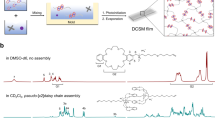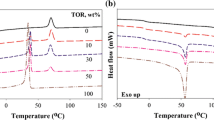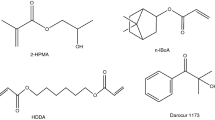Abstract
The variation of the molecular architecture of multiblock copolymers has enabled the introduction of functional behaviour and the control of key mechanical properties. In the current study, we explore the synergistic relationship of two structural components in a shape-memory material formed of a multiblock copolymer with crystallizable poly(ε-caprolactone) and crystallizable poly[oligo(3S-iso-butylmorpholine-2,5-dione)] segments (PCL-PIBMD). The thermal and structural properties of PCL-PIBMD films were compared with PCL-PU and PIBMD-PU, investigated by means of DSC, SAXS and WAXS measurements. The shape-memory properties were quantified by cyclic, thermomechanical tensile tests, where deformation strains up to 900% were applied for programming PCL-PIBMD films at 50 °C. Toluene vapor treatment experiments demonstrated that the temporary shape was fixed mainly by glassy PIBMD domains at strains lower than 600%, with the PCL contribution to fixation increasing to 42±2% at programming strains of 900%. This study into the shape-memory mechanism of PCL-PIBMD provides insight into the structure-function relation in multiblock copolymers with both crystallizable and glassy switching segments.
Similar content being viewed by others

References
K. K. Julich-Gruner, C. Löwenberg, A. T. Neffe, M. Behl and A. Lendlein, Macromolecular Chemistry and Physics 214 (5), 527–536 (2012).
M. Behl, U. Ridder, Y. Feng, S. Kelch and A. Lendlein, Soft Matter 5 (3), 676–684 (2009).
T. Xie, Polymer 52 (22), 4985–5000 (2011).
J. Hu, Y. Zhu, H. Huang and J. Lu, Progress in Polymer Science 37 (12), 1720–1763 (2012).
X. J. Han, Z. Q. Dong, M. M. Fan, Y. Liu, Y. F. Wang, Q. J. Yuan, B. J. Li and S. Zhang, Macromolecular rapid communications 33 (12), 1055–1060 (2012).
A. Lendlein, H. Jiang, O. Jünger and R. Langer, Nature 434 (7035), 879–882 (2005).
M. Y. Razzaq, M. Anhalt, L. Frormann and B. Weidenfeller, Materials Science and Engineering: A 444 (1), 227–235 (2007).
M. Y. Razzaq and L. Frormann, Polymer Composites 28 (3), 287–293 (2007).
A. Lendlein and S. Kelch, Angewandte Chemie International Edition 41 (12), 2034–2057 (2002).
P. T. Mather, X. Luo and I. A. Rousseau, Annual Review of Materials Research 39, 445–471 (2009).
C. Min, W. Cui, J. Bei and S. Wang, Polymers for Advanced Technologies 16 (8), 608–615 (2005).
K. Kratz, U. Voigt and A. Lendlein, Advanced Functional Materials 22 (14), 3057–3065 (2012).
H. Matsumoto, T. Ishiguro, Y. Konosu, M. Minagawa, A. Tanioka, K. Richau, K. Kratz and A. Lendlein, European Polymer Journal 48 (11), 1866–1874 (2012).
Y. Feng, M. Behl, S. Kelch and A. Lendlein, Macromolecular Bioscience 9 (1), 45–54 (2009).
W. Yan, L. Fang, U. Noechel, K. Kratz and A. Lendlein, Express Polymer Letters 9 (7), 624–635 (2015).
W. Yan, L. Fang, U. Noechel, K. Kratz and A. Lendlein, Journal of Polymer Science Part B: Polymer Physics 54 (19), 1935–1943 (2016).
T. Sauter, M. Heuchel, K. Kratz and A. Lendlein, Polymer Reviews 53 (1), 6–40 (2013).
P. Scherrer, Bestimmung der inneren Struktur und der Größe von Kolloidteilchen mittels Röntgenstrahlen. In: Kolloidchemie Ein Lehrbuch, Chemische Technologie in Einzeldarstellungen. (Springer, Berlin, 1912).
N. Stribeck, X-ray scattering of soft matter. (Springer Science & Business Media, Berlin, 2007).
W. Yan, T. Rudolph, U. Noechel, O. Gould, M. Behl, K. Kratz and A. Lendlein, Macromolecules 51 (12), 4624–4632 (2018).
Author information
Authors and Affiliations
Corresponding author
Rights and permissions
About this article
Cite this article
Yan, W., Fang, L., Noechel, U. et al. Investigating the Roles of Crystallizable and Glassy Switching Segments within Multiblock Copolymer Shape-Memory Materials. MRS Advances 3, 3741–3749 (2018). https://doi.org/10.1557/adv.2018.590
Published:
Issue Date:
DOI: https://doi.org/10.1557/adv.2018.590



